The demand for 2-ethyl anthraquinone in Japan is expected to grow from USD 278.2 million in 2025 to USD 407.9 million by 2035, reflecting a compound annual growth rate (CAGR) of 3.9%. This compound is primarily used in the production of hydrogen peroxide, which is essential in various industries, including paper and pulp, textiles, water treatment, and chemicals. As demand for hydrogen peroxide rises, particularly in sectors focused on durability and environmental efficiency, the demand for 2-ethyl anthraquinone is projected to grow steadily.
In Japan, the shift towards cleaner technologies and green manufacturing processes is driving the increased demand for 2-ethyl anthraquinone. The compound’s critical role in producing hydrogen peroxide, an environmentally friendly bleaching agent and disinfectant, makes it increasingly vital to industries aiming to reduce carbon footprints and improve energy efficiency. Hydrogen peroxide's use in applications such as water treatment and as an industrial cleaning agent further supports its growing importance.

Technological advancements in hydrogen peroxide production that improve yield and reduce costs are expected to contribute to the increased demand for 2-ethyl anthraquinone. As industries in Japan continue to prioritize environmental durability and efficiency, 2-ethyl anthraquinone’s role in producing hydrogen peroxide will remain integral to meeting these industrial and environmental goals, further driving industry growth.
Between 2025 and 2030, the demand for 2-ethyl anthraquinone in Japan is expected to grow from USD 278.2 million to USD 289.1 million. During this period, growth will be moderate, driven primarily by steady demand in established sectors like paper and pulp, chemicals, and textiles. As industries maintain their adoption of hydrogen peroxide for various industrial processes, the industry will experience gradual expansion. The saturation point in this phase will remain low, as 2-ethyl anthraquinone continues to be widely used for hydrogen peroxide production, but its penetration across new industries will still be developing.
From 2030 to 2035, the demand for 2-ethyl anthraquinone is expected to rise more significantly, reaching USD 407.9 million. This accelerated growth will occur as the adoption of hydrogen peroxide expands into new applications, including in the renewable energy sector and in more green industrial processes. As these new sectors adopt hydrogen peroxide at higher volumes, the industry for 2-ethyl anthraquinone will experience a higher saturation point. The increased efficiency in hydrogen peroxide production and its broader use across various industries will drive this industry shift, resulting in a sharp increase in demand for 2-ethyl anthraquinone by the end of the forecast period.
| Metric | Value |
|---|---|
| Demand for 2-Ethyl Anthraquinone in Japan Value (2025) | USD 278.2 million |
| Demand for 2-Ethyl Anthraquinone in Japan Forecast Value (2035) | USD 407.9 million |
| Demand for 2-Ethyl Anthraquinone in Japan Forecast CAGR (2025-2035) | 3.9% |
The demand for 2-Ethyl Anthraquinone in Japan is increasing primarily due to its key role in the production of hydrogen peroxide, a critical chemical used in various industrial applications. 2-Ethyl Anthraquinone acts as a catalyst in the anthraquinone process, which is the most widely used method for producing hydrogen peroxide. As industries across Japan continue to focus on more efficient and green chemical processes, the adoption of 2-Ethyl Anthraquinone is expanding.
The growing need for hydrogen peroxide in environmental applications, such as wastewater treatment and pollution control, is a significant driver. Hydrogen peroxide is widely used as an eco-friendly oxidizing agent for treating contaminants, and its growing application in both industrial and municipal settings is driving demand for 2-Ethyl Anthraquinone. Its use in the pulp and paper industry for bleaching and in the textile industry for various processes further supports its demand.
Technological advancements in hydrogen peroxide production, along with an increasing focus on green chemical processes, are contributing to the rising demand for 2-Ethyl Anthraquinone. As Japan continues to prioritize eco-friendly and cost-effective solutions, the role of 2-Ethyl Anthraquinone in hydrogen peroxide production becomes even more important, ensuring steady growth through 2035.
Demand for 2-ethyl anthraquinone in Japan is segmented by chemical type, application, and region. By chemical type, demand is divided into crystals and granules, with crystals holding the largest share at 60%. The demand is also segmented by application, including textile, paper, detergent bleaches, water purification, and others, with textile leading the demand at 46.8%. Regionally, demand is divided into Kyushu & Okinawa, Kanto, Kinki, Chubu, Tohoku, and the Rest of Japan.
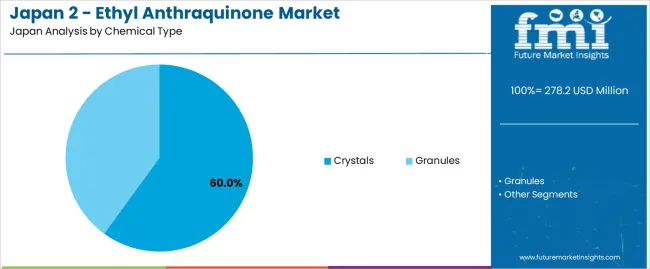
Crystals account for 60% of the demand for 2-ethyl anthraquinone in Japan. Crystals are favored due to their high purity, which is essential for their effectiveness as a catalyst in the production of hydrogen peroxide. The high purity ensures that the chemical reactions required in various applications, especially in the textile and paper industries, occur efficiently and consistently. Crystalline 2-ethyl anthraquinone is also easier to handle and store compared to other forms like granules, making it more practical for large-scale industrial use. In the textile industry, where it is used for bleaching, the ability of crystalline 2-ethyl anthraquinone to produce hydrogen peroxide reliably and at scale is crucial. Its stability and compatibility with other industrial processes ensure that crystals remain the preferred form for various applications. As industries continue to seek high-performance chemicals, crystalline 2-ethyl anthraquinone will maintain its leading role in the industry.
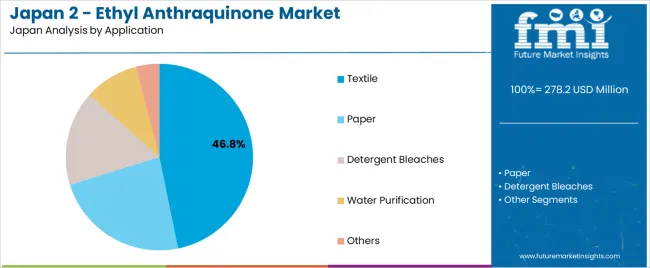
The textile industry accounts for 46.8% of the demand for 2-ethyl anthraquinone in Japan. This chemical is primarily used in the production of hydrogen peroxide, which is essential for the bleaching process of fabrics. 2-Ethyl anthraquinone serves as a catalyst in the anthraquinone process, which efficiently generates hydrogen peroxide from oxygen. The textile industry relies heavily on hydrogen peroxide for fabric whitening, particularly for cotton and synthetic materials, which drives the demand for 2-ethyl anthraquinone. As the demand for high-quality textiles and eco-friendlier production processes grows, the role of 2-ethyl anthraquinone in textile manufacturing becomes increasingly important. The growing focus on improving textile processing efficiency, alongside the need for cleaner production methods, ensures the continued dominance of 2-ethyl anthraquinone in the textile industry. The increasing demand for bleached textiles worldwide supports its central role in this application.
In Japan, demand for 2‑EAQ is driven by the need for high‑purity intermediates used in the large‑scale production of Hydrogen Peroxide (H₂O₂), which is applied across water treatment, electronics cleaning, textile bleaching and paper/pulp manufacture. Japan’s chemical‑industrial base emphasizes cleaner production and regulatory compliance, increasing uptake of H₂O₂ via the anthraquinone process, thereby stimulating 2‑EAQ demand. On the restraint side, production and supply remain challenged by capital‑intensive infrastructure, high energy and feedstock costs, and competition from alternative oxidants or emerging H₂O₂ technologies.
Why is Demand for 2‑EAQ Growing in Japan?
Demand for 2‑EAQ in Japan is increasing because H₂O₂, which relies on 2‑EAQ as an intermediate in its production process, is widely used in industries such as semiconductor cleaning, electronics manufacturing, food‑grade bleaching, and wastewater treatment. As Japan places greater emphasis on environmental durability, there is a regulatory push toward eco‑friendly chemicals, further supporting H₂O₂ demand. Japan’s strong chemical‑manufacturing infrastructure and its global industry reach contribute to consistent usage of 2‑EAQ‑derived H₂O₂ in essential industries, making it a critical component in industrial operations. These factors combine to drive sustained growth in demand for 2‑EAQ in Japan’s evolving chemical industry.
How are Technological Innovations Driving Growth of 2‑EAQ in Japan?
Technological innovations in Japan are supporting the growth of 2‑EAQ by improving production processes and material handling. Enhanced catalysts and purification methods for 2‑EAQ synthesis help increase yields and reduce impurities, enabling higher‑quality H₂O₂ production. Innovations in material form, such as granules or crystals, improve handling and logistics, making 2‑EAQ more efficient to use. Advancements in supply chain management have improved the availability and distribution of 2‑EAQ. These improvements make 2‑EAQ a more cost‑effective and reliable option for Japanese chemical producers, particularly in high‑grade H₂O₂ applications, thereby driving growth in its use across critical sectors.
What are the Key Challenges Limiting Adoption of 2‑EAQ in Japan?
Despite steady demand, several challenges limit the adoption of 2‑EAQ in Japan. The high cost of production, driven by the need for energy and specialized feedstocks, makes it less competitive compared to alternative H₂O₂ production methods or other oxidants. The supply chain for 2‑EAQ remains vulnerable, as domestic production relies on imported precursors or outsourcing, reducing supply flexibility. Technological shifts in the production of H₂O₂ or the development of alternative oxidants may further limit the long‑term demand for 2‑EAQ. These factors, combined with the capital‑intensive nature of 2‑EAQ production, pose barriers to the broader adoption of the material in Japan.
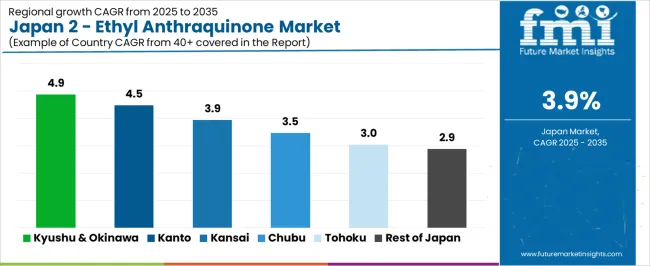
| Region | CAGR (%) |
|---|---|
| Kyushu & Okinawa | 4.9% |
| Kanto | 4.5% |
| Kinki | 3.9% |
| Chubu | 3.5% |
| Tohoku | 3.0% |
| Rest of Japan | 2.9% |
Demand for 2-Ethyl Anthraquinone in Japan is growing steadily across all regions, with Kyushu & Okinawa leading at a 4.9% CAGR. Kanto follows with a 4.5% CAGR, supported by its large chemical and pharmaceutical industries that use 2-Ethyl Anthraquinone for producing hydrogen peroxide and other industrial chemicals. Kinki shows a 3.9% CAGR, with demand driven by the region’s manufacturing sector, including food processing and paper industries. Chubu experiences a 3.5% CAGR, fueled by its strong industrial focus on chemicals and energy sectors. Tohoku shows a 3.0% CAGR, with moderate demand driven by its focus on manufacturing and environmental applications. The Rest of Japan has the lowest growth at 2.9%, but demand remains steady due to industrial and agricultural uses of hydrogen peroxide.
Kyushu & Okinawa are experiencing the highest demand for 2-Ethyl Anthraquinone in Japan, with a 4.9% CAGR. The demand in this region is driven by its robust chemical manufacturing and industrial sectors, particularly in the production of hydrogen peroxide. 2-Ethyl Anthraquinone is a critical component in the production of hydrogen peroxide, which is used in various applications such as bleaching, water treatment, and chemical processes. Kyushu & Okinawa's significant manufacturing base, including refineries and chemical plants, relies on hydrogen peroxide, boosting the need for 2-Ethyl Anthraquinone. The region’s focus on modernizing industrial practices and increasing efficiency in chemical production plays a key role in driving this demand. As the region continues to expand its industrial and chemical sectors, and with a growing emphasis on durability, the demand for 2-Ethyl Anthraquinone is expected to remain strong.
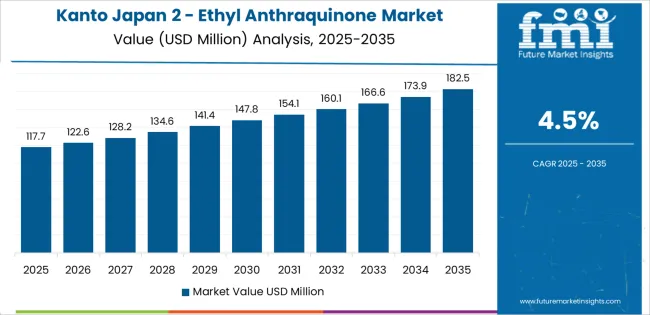
Kanto is experiencing steady demand for 2-Ethyl Anthraquinone in Japan, with a 4.5% CAGR. The region’s industrial base, particularly in chemical, pharmaceutical, and manufacturing sectors, drives the growing need for 2-Ethyl Anthraquinone. Kanto, home to Japan's industrial and commercial heart, has a high concentration of manufacturing facilities that use hydrogen peroxide for various industrial processes such as bleaching, sterilization, and water treatment. With Tokyo and Yokohama being major hubs for chemical production, the region's need for 2-Ethyl Anthraquinone to support hydrogen peroxide manufacturing remains strong. Kanto's commitment to durability and energy-efficient practices in the chemical industry further supports the demand for this compound. As industries continue to focus on reducing environmental impact and improving manufacturing efficiency, the demand for 2-Ethyl Anthraquinone will likely see sustained growth.
Kinki is experiencing moderate demand for 2-Ethyl Anthraquinone in Japan, with a 3.9% CAGR. This growth is supported by the region's established industrial base, particularly in chemical manufacturing, food production, and paper industries, all of which require hydrogen peroxide. The region’s strong focus on industrial efficiency, combined with the demand for chemicals in sectors like paper production and food processing, ensures steady demand for 2-Ethyl Anthraquinone. As Kinki is home to Osaka and Kyoto, two key cities for manufacturing and technology, the demand for this compound to support hydrogen peroxide production is expected to grow steadily. The region’s increasing emphasis on durability in its industrial operations further drives the use of hydrogen peroxide in environmental applications like wastewater treatment. Kinki’s continued industrial expansion and growing focus on energy-efficient practices ensure consistent demand for 2-Ethyl Anthraquinone.
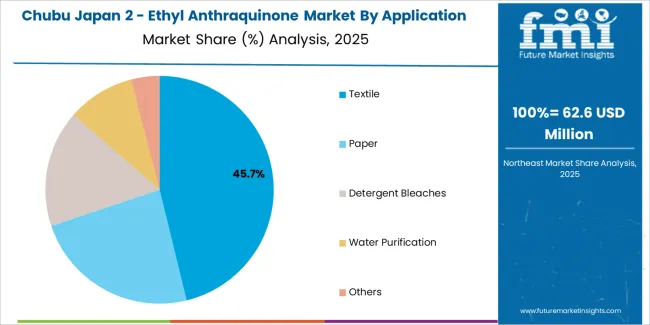
Chubu is seeing steady demand for 2-Ethyl Anthraquinone in Japan, with a 3.5% CAGR. The region's industrial growth, particularly in automotive manufacturing and chemical production, is a key driver of this demand. Chubu is home to cities like Nagoya, a major automotive hub, and the region's strong chemical manufacturing base boosts the need for hydrogen peroxide, used in a variety of industrial processes such as bleaching, oxidation, and wastewater treatment. The increasing focus on energy efficiency and environmental durability in Chubu’s manufacturing sector further supports the demand for 2-Ethyl Anthraquinone. As the region continues to focus on improving industrial practices and reducing carbon footprints, the use of hydrogen peroxide in clean manufacturing processes will drive steady growth. The demand for 2-Ethyl Anthraquinone will continue to rise as industries in Chubu seek more efficient and environmentally friendly chemical solutions.
Tohoku is experiencing moderate demand for 2-Ethyl Anthraquinone in Japan, with a 3.0% CAGR. The region’s focus on agriculture, manufacturing, and renewable energy contributes to steady demand for this chemical. Hydrogen peroxide, produced using 2-Ethyl Anthraquinone, plays a crucial role in agricultural applications, including crop treatment and water purification. Tohoku’s growing industrial base, particularly in manufacturing and energy sectors, supports the use of 2-Ethyl Anthraquinone in chemical processes. The region’s emphasis on clean energy technologies, including solar and wind power, also drives the demand for hydrogen peroxide in renewable energy applications. Although the growth rate is slower compared to more industrialized regions, Tohoku’s focus on innovation in agriculture and energy production ensures that the demand for 2-Ethyl Anthraquinone will remain steady. As industries in Tohoku continue to invest in energy-efficient and clean technologies, the demand for this compound will gradually increase.
The Rest of Japan is seeing the lowest growth in demand for 2-Ethyl Anthraquinone, with a 2.9% CAGR. The demand in this region is primarily driven by its smaller industrial sectors, including agriculture, food processing, and light manufacturing. Hydrogen peroxide is used for various applications such as food bleaching, sterilization, and water treatment, which are common in the region’s agricultural and food industries. While the Rest of Japan’s industrial activity is less concentrated compared to regions like Kanto or Kyushu & Okinawa, the consistent use of 2-Ethyl Anthraquinone in regional manufacturing and agricultural operations ensures steady demand. The region's ongoing investments in improving industrial efficiency and environmental durability will continue to support the need for hydrogen peroxide and, consequently, for 2-Ethyl Anthraquinone. Despite slower growth, the Rest of Japan’s demand remains stable, driven by agricultural and regional industrial applications.
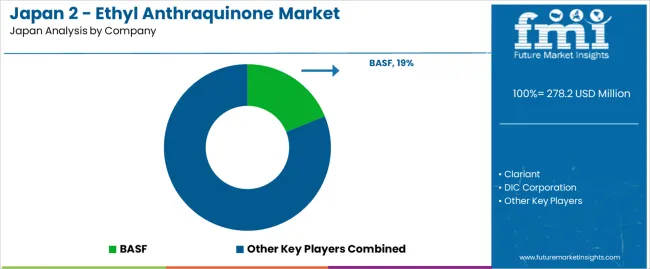
In Japan, demand for 2‑Ethyl Anthraquinone is largely driven by its critical role as an intermediate in the production of hydrogen peroxide, which is widely used in industries such as paper & pulp, textiles, chemical processing, and wastewater treatment. As Japan continues to modernize its manufacturing base, emphasize cleaner production technologies and upgrade its industrial‑chemical infrastructure, the uptake of 2‑Ethyl Anthraquinone supports those broader process‑chemistry trends.
Key suppliers in this sector include BASF SE holding around an 18.9 % share, along with Clariant International Ltd., DIC Corporation, Hebei Kailite Sensitizing Chemicals Co. Ltd. and Henan Baofeng Chemical Industry Co. Ltd. These companies differentiate themselves through large‑scale catalytic intermediate manufacturing, high‑purity grades needed for hydrogen‑peroxide production, strategic partnerships with Japanese chemical firms and robust supply‑chain and regulatory‑compliance track‑records within Japan’s chemical‑industry ecosystem.
The competitive dynamics are shaped by several key factors. First, the continued demand for hydrogen peroxide in Japan’s chemical‑processing, bleaching and environmental‑treatment sectors underpins use of 2‑Ethyl Anthraquinone. Second, requirements for process‑efficiency, chemical‑purity and lower‑impurity intermediate supply make technical capability and local service support important competitive levers. Third, challenges include the capital‑intensive nature of manufacturing, volatility in raw‑material cost (anthraquinone derivatives and ethylene feeds), regulatory/compliance burdens, and competition from alternative processes or substitute chemistries seeking to replace the anthraquinone cycle. Supplier firms that can offer consistent quality, dependable supply‑chains, high‑purity intermediate grades and adept regulatory‑support are best placed to succeed in Japan’s 2‑Ethyl Anthraquinone landscape.
| Items | Values |
|---|---|
| Quantitative Units (2025) | USD million |
| Chemical Type | Crystals, Granules |
| Application | Textile, Paper, Detergent Bleaches, Water Purification, Others |
| Region | Kyushu & Okinawa, Kanto, Kinki, Chubu, Tohoku, Rest of Japan |
| Countries Covered | Japan |
| Key Companies Profiled | BASF, Clariant, DIC Corporation, Hebei Kailite Sensitizing Chemicals Co., Ltd., Henan Baofeng Chemical Industry Co., Ltd. |
| Additional Attributes | Dollar sales by chemical type and application; regional CAGR and adoption trends; demand trends in 2-ethyl anthraquinone; growth in textile, paper, and detergent sectors; technology adoption for chemical processing; vendor offerings including raw materials and solutions; regulatory influences and industry standards |
The demand for 2 - ethyl anthraquinone in japan is estimated to be valued at USD 278.2 million in 2025.
The market size for the 2 - ethyl anthraquinone in japan is projected to reach USD 407.9 million by 2035.
The demand for 2 - ethyl anthraquinone in japan is expected to grow at a 3.9% CAGR between 2025 and 2035.
The key product types in 2 - ethyl anthraquinone in japan are crystals and granules.
In terms of application, textile segment is expected to command 46.8% share in the 2 - ethyl anthraquinone in japan in 2025.






Our Research Products

The "Full Research Suite" delivers actionable market intel, deep dives on markets or technologies, so clients act faster, cut risk, and unlock growth.

The Leaderboard benchmarks and ranks top vendors, classifying them as Established Leaders, Leading Challengers, or Disruptors & Challengers.

Locates where complements amplify value and substitutes erode it, forecasting net impact by horizon

We deliver granular, decision-grade intel: market sizing, 5-year forecasts, pricing, adoption, usage, revenue, and operational KPIs—plus competitor tracking, regulation, and value chains—across 60 countries broadly.

Spot the shifts before they hit your P&L. We track inflection points, adoption curves, pricing moves, and ecosystem plays to show where demand is heading, why it is changing, and what to do next across high-growth markets and disruptive tech

Real-time reads of user behavior. We track shifting priorities, perceptions of today’s and next-gen services, and provider experience, then pace how fast tech moves from trial to adoption, blending buyer, consumer, and channel inputs with social signals (#WhySwitch, #UX).

Partner with our analyst team to build a custom report designed around your business priorities. From analysing market trends to assessing competitors or crafting bespoke datasets, we tailor insights to your needs.
Supplier Intelligence
Discovery & Profiling
Capacity & Footprint
Performance & Risk
Compliance & Governance
Commercial Readiness
Who Supplies Whom
Scorecards & Shortlists
Playbooks & Docs
Category Intelligence
Definition & Scope
Demand & Use Cases
Cost Drivers
Market Structure
Supply Chain Map
Trade & Policy
Operating Norms
Deliverables
Buyer Intelligence
Account Basics
Spend & Scope
Procurement Model
Vendor Requirements
Terms & Policies
Entry Strategy
Pain Points & Triggers
Outputs
Pricing Analysis
Benchmarks
Trends
Should-Cost
Indexation
Landed Cost
Commercial Terms
Deliverables
Brand Analysis
Positioning & Value Prop
Share & Presence
Customer Evidence
Go-to-Market
Digital & Reputation
Compliance & Trust
KPIs & Gaps
Outputs
Full Research Suite comprises of:
Market outlook & trends analysis
Interviews & case studies
Strategic recommendations
Vendor profiles & capabilities analysis
5-year forecasts
8 regions and 60+ country-level data splits
Market segment data splits
12 months of continuous data updates
DELIVERED AS:
PDF EXCEL ONLINE
2 - Ethyl Anthraquinone Market Growth - Trends & Forecast 2025 to 2035
2-Ethyl-3,4-ethylenedioxythiophene Market Size and Share Forecast Outlook 2025 to 2035
2-EthylHexyl Acetate Market Size and Share Forecast Outlook 2025 to 2035
2-ethylhexanol (2-EH) Market Growth - Trends & Forecast 2025 to 2035
2-Methylfuran Market Size and Share Forecast Outlook 2025 to 2035
Japan I2C Bus Market - Trends & Forecast 2025 to 2035
Methyl 2-Fluoro-3-Oxopentanoate Market Size and Share Forecast Outlook 2025 to 2035
Methyl 2-Naphthyl Ether Market Size and Share Forecast Outlook 2025 to 2035
N-Ethyl-2-Pyrrolidone Market Growth - Trends & Forecast 2025 to 2035
2-(4-(Bromomethyl)phenyl)propionic Acid (BMPPA) Market Forecast and Outlook 2025 to 2035
N-Methyl-2-Pyrrolidone Market Trends – Size, Demand & Forecast 2024–2034
Methyl 3-Methyl-2-Butenoate Market Size and Share Forecast Outlook 2025 to 2035
3-Methyl-3-penten-2-one (3M3P) Market Forecast and Outlook 2025 to 2035
Japan Faith-based Tourism Market Size and Share Forecast Outlook 2025 to 2035
Japan Sports Tourism Market Size and Share Forecast Outlook 2025 to 2035
Ethylene Carbonate Market Size and Share Forecast Outlook 2025 to 2035
Ethylene Glycol Market Forecast and Outlook 2025 to 2035
2-tert-Butylcyclohexanol Market Forecast and Outlook 2025 to 2035
2-Fluorobenzotrifluoride Market Forecast and Outlook 2025 to 2035
2-Methoxynaphthalene-1-Boronic Acid Market Forecast and Outlook 2025 to 2035

Thank you!
You will receive an email from our Business Development Manager. Please be sure to check your SPAM/JUNK folder too.
Chat With
MaRIA